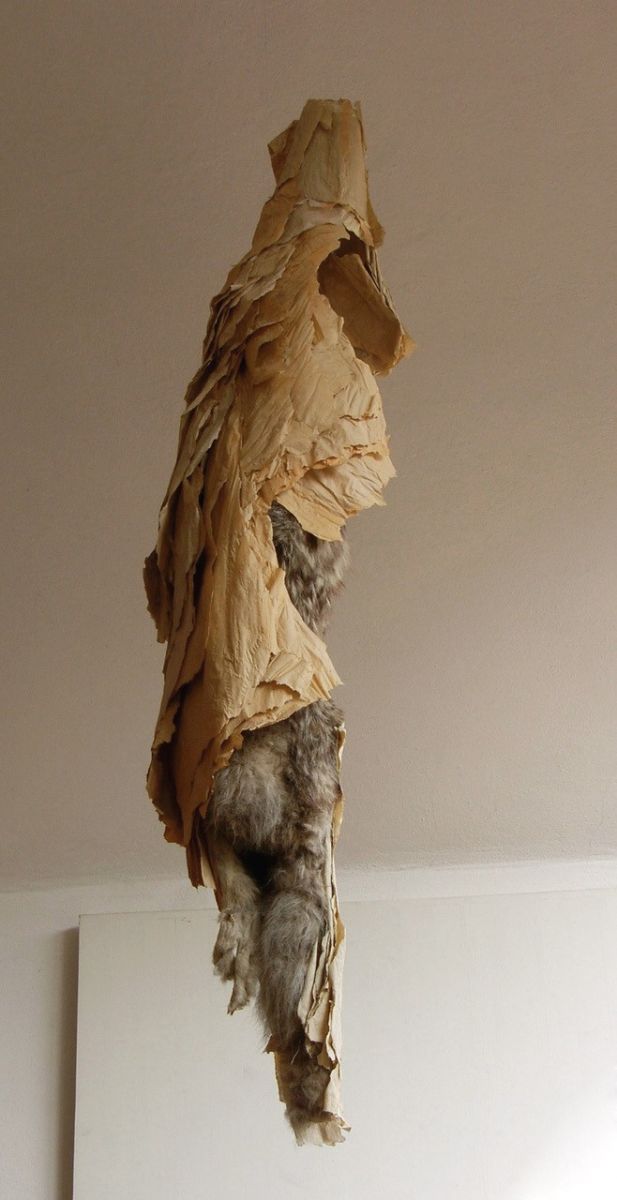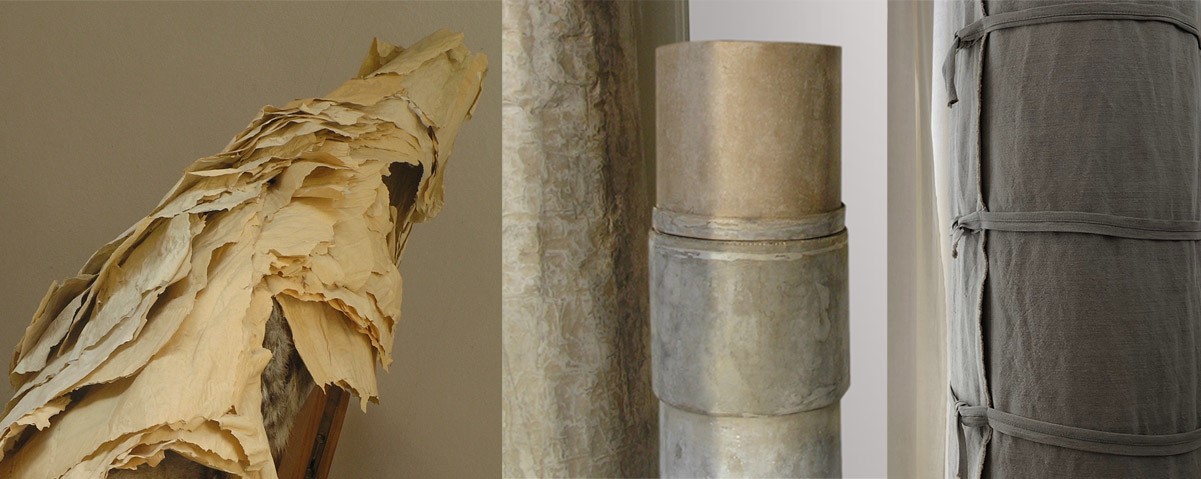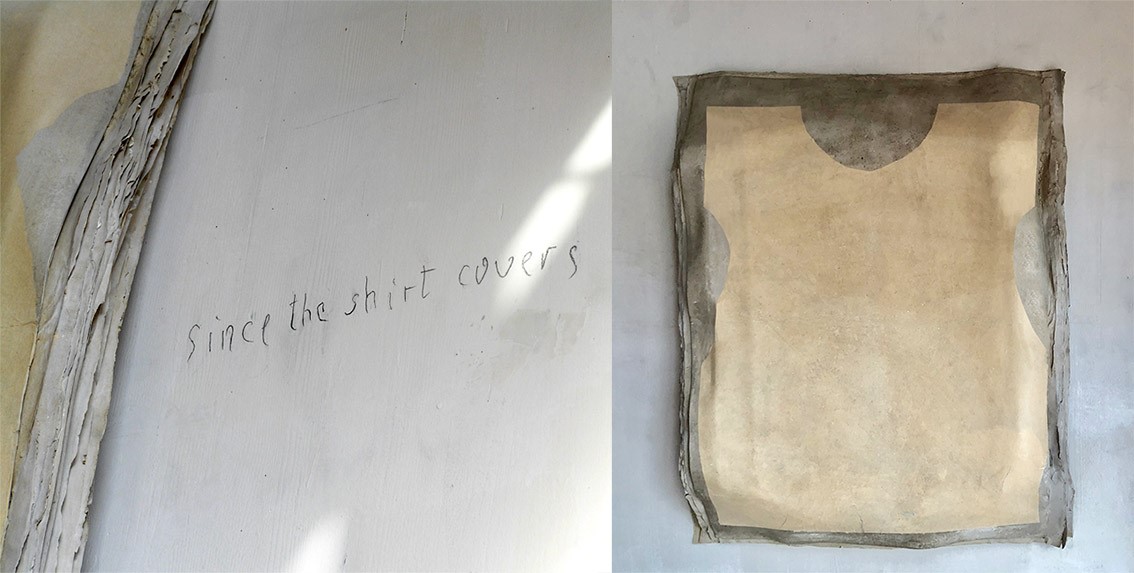Westerfrölke, Anja - VM - Marleen Hengelaar
Anja Westerfrölke: Coyote (since the shirt covers)

Fur and Linen
by Marleen Hengelaar-Rookmaaker
Anja Westerfrölke is an Austrian conceptual artist who often works with textile materials. She knows the characteristics and qualities of each texture, its associations and symbolical meanings. She is also well-aware of the rich symbolism that is attached to fabrics and garments in the Bible. In Coyote she draws from this wellspring of meaning to talk about redemption and resurrection.
Westerfrölke remarks, “By work referring to spiritual and cultural heritage I want to provide traces for viewers to relate experiences to, to ask questions and wonder about, to open up to, to be disturbed by. I want to create models that make people see reality from a different point of view.” Westerfrölke normally does not show her work in churches or venues that specialize in religious art, yet she is open to making work for Christian contexts.

Coyote consists of several elements. First the fur of the coyote, partly covered with a second skin of paper. Secondly a container for this object made from more layers of paper. Thirdly a textile layer of natural linen to be wrapped around the container. Fourthly a plastic tube (not shown in the picture) as an additional waterproof case which is needed when the artwork will travel. These four parts together form the first object of the installation. All these covers are as much a part of the artwork as the inside object. Then there is a second object that hangs on the wall next to the coyote. It is made up again of layers of paper, this time with a white shape of a simple T-shirt on top. Next to it “since the shirt covers” is written on the wall.
This multilayered work needs unpacking. The coyote skin of the first object is a magnificent piece of textile – natural, wild and pure. This innocent animal was killed, sacrificed, so that its meat could be eaten and its fur offer warmth in the cold. The title of the work contains an unmistakable reference to Joseph Beuys’ famous performance with a coyote – I like America and America likes me, 1974, at the René Block Gallery in SoHo, NYC when he was wrapped in felt, holding a shepherd’s crook, and locked up with a coyote eight hours over the course of three days – which addresses the relationship of the white invaders with the indigenous peoples of America. Out of reverence and respect for nature the natives do not cut the coyote open to obtain the meat within, but take it out while leaving the skin intact, ending up with an unblemished empty skin. Sacrifice, an innocent creature being killed by humans, reverence, an empty skin that first contained a dead body – yes, these are all references to Christ and his work of redemption.
The artist covered the skin by layers of paper, at the top modelled into the face of a howling coyote, crying out in loneliness and pain. The meaning and importance of Christ’s sacrifice come out in the multiple layers of paper: testimonies to the books, theologies, poems, songs, memoirs etc. that have sprung forth from this crucial point in history. The value of the covered coyote is emphasized even more by the hatbox-like container in which the special object can be carefully stored – like a hat that is taken out on festive occasions – and preserved for future generations.
Then there is yet another coat that can be wrapped around the container, this time made of pure linen. Two biblical references to linen come to mind: the linen cloth that was wrapped around Jesus’ dead body and found by Peter in the empty tomb (Luke 23:53; 24:11), and the bride of the Lamb who “has been granted to be clothed with fine linen, bright and pure – for the fine linen is the righteous deeds of the saints” (Revelation 19:8). Both speak of the resurrection of Jesus and the saints.
A waterproof case forms the final cover for the coyote object, another token of respect and care.

While the first object can be said to evolve around Christ, the second object focuses on humanity. The many layers of paper point to the ‘pages’ of human history with its manifold manifestations of individual acts. This pile of pages is hidden beneath the very basic form of a shirt that is common to all peoples. Its white colour hints at the garments of salvation and the festal robes of the faithful clothed with righteousness, as mentioned in various places in Scripture. The grace-filled words “Since the shirt covers” are given added depth by the layers in the coyote object – covering, honoring, preserving. As Westerfrölke concludes, “The material skin and historical, cultural covers convey an immaterial message, like the linen found by the women in the empty tomb on Easter morning.”
*******
Anja Westerfrölke: Coyote (since the shirt covers), 2004/2011, animal skin, paper, linen; tube 170 cm long, shirt 90 x 70 x 7cm.
Anja Westerfrölke was born in Germany. She lives and works in Linz, Austria, as a textile and new media artist. Her understanding of art as a collaborative and communicative event underlies her work and teaching. She has had exhibitions at home and abroad using installations, performance, video, internet, text and textile in public art institutions and site-specific situations. “As an artist I suggest, involve, provoke. Being a woman, my gender shapes the way I approach and encounter reality. I trust in the God Jesus Christ refers to. Yet, ‘artistic’, ‘female’ and ‘Christian’ are adjectives I like to challenge. Centuries of art production, feminism and biblical theology provide the references I need.” www.anja.west.servus.at
Marleen Hengelaar-Rookmaaker is editor-in-chief of ArtWay.
ArtWay Visual Meditation 14 June 2020


